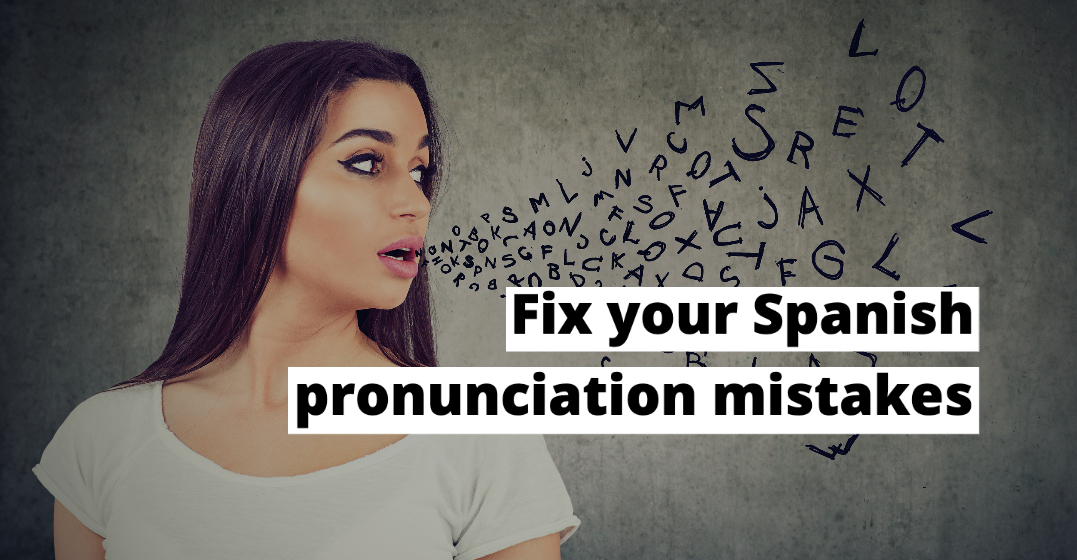Updated on January 9, 2024

5 common pronunciation mistakes for Spanish learners

When you learn Spanish at home or take one-on-one online Spanish lessons, you have an advantage over classroom learners. Your tutor can focus specifically on your pronunciation. A teacher who makes sure to catch and correct your Spanish pronunciation is key to your improvement.
The best way to learn Spanish is to mimic native speakers. We’ve talked before about how to have a Spanish accent. As native English speakers, today we will focus on un-learning English letter pronunciations.
For the English letter R, the tip of the tongue never touches the gum ridge or teeth. Linguistically speaking, it is a voiced (post)alveolar R. Linguists call this a “liquid” R because there is no phonetic stoppage. It’s a smooth transition between previous and following sounds: bleary, rent, clearly, road, sorry.
The Spanish R is never liquid. We detailed the two pronunciations of Spanish letter R in our blog post about how to roll the Spanish R, but basically there is the ‘trilled’ R and the single r. The single R in Spanish is just a tap of the tongue like the English /d/ noise. The double RR is a full trill. These two sounds are audibly distinct between the words pero vs. perro (PE-do vs. PE-RRo). Using a liquid R is a mistake from non-native speakers.
For the letter D in English, air is stopped by the tongue pressing against the tooth ridge and upper side teeth. The sound is aspirated when the air is released, making an explosive sound: darn. The Spanish D is different. It is a voiced ‘th’ /ð/ sound such as in English words: this, thus, though, thither, the. When you say “de nada” in Spanish, it is a softer fricative noise: THE NA-tha.
In English the letter P is aspirated. That means by closing the lips, air is prevented from leaving the vocal tract. When the lips part, the air is released and you get the English P noise as in Peppa Pig Party. In Spanish the letter P is never aspirated. It’s like when a P occurs at the end of English words: lap, tip, cap. The lips do touch but there is no puff of air. Paloma or dove in Spanish (also the name of a delicious Mexican tequila and grapefruit cocktail) is pronounced without that puff of air.
The letter H in Spanish is never pronounced. For hola, Hector, habichuela, hondureña, and albahaca they are all pronounced as if the H does not exist: ola, ector, abichuela, ondureña, alba-aca. Spanish learners often forget this rule while they are reading or talking and aspirate the H. Learn to notice it and pronounce it correctly, which means not pronouncing it at all.
The best way to learn Spanish pronunciation from the start is to focus on your vowel sounds. In English, each vowel has multiple possible pronunciations. For example the vowel A has three pronunciations: the short vowel sound -a, the long vowel sound like the letter -A, and the –ah sound. These three sounds can be seen in three different words: rabbit, dare, and far (r-a-bbit, d-A-re, and f-ah-r).
In Spanish the vowel A has only one sound. The Spanish A closely matches the 3rd –ah pronunciation in English. In Spanish you will never hear –a as in rabbit or –A as in dare. Spanish vowels are 100% consistent in their pronunciation regardless of the word so you can be sure to always read the letter A as –ah.
From the letters R, D, P, and H to the consistent vowel sounds, fix your major Spanish pronunciation mistakes by reading Spanish names aloud. For example Pilar is not phuh-LARR but pee-LAD. Practise with your own friends’ names or watch Spanish movies on Netflix. Listening to how native Spanish speakers pronounce their own names is the best way to reinforce correct pronunciation.
Fix your Spanish pronunciation mistakes today with Lingoda! Take advantage of a free 7-day trial with our native speaking Spanish teachers and get custom feedback today.